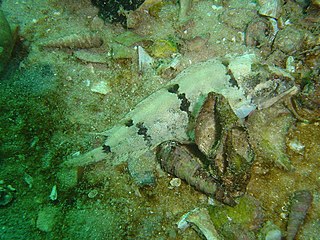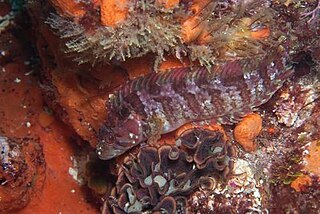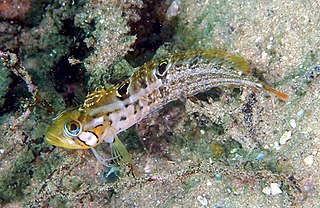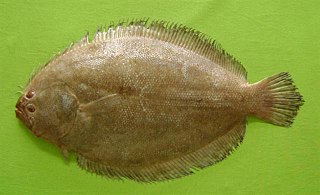
The starry flounder, also known as the grindstone, emery wheel and long-nosed flounder, is a common flatfish found around the margins of the North Pacific.
This glossary of ichthyology is a list of definitions of terms and concepts used in ichthyology, the study of fishes.

The silver drummer, also known as the buff bream, buffalo bream, buffs, common buffalo bream, drummer bream, Southern silver drummer or Sydney drummer, is a species of marine ray-finned fish, a sea chub from the family Kyphosidae. It is found in the southeastern Indian Ocean and the southwestern Pacific Ocean off Australia and New Zealand where they are found in shallow water near rocky reefs.

The northern sawtail catshark is a little-known species of catshark, and part of the family Scyliorhinidae, endemic to northeastern Australia. It is demersal in nature and inhabits the upper continental slope at a depth of 300–420 m (980–1,380 ft). A small, slender species growing no longer than 42 cm (17 in), the northern sawtail catshark is characterized by a series of dark, narrow saddles along its back and tail, and rows of prominently enlarged dermal denticles along the upper edge of its caudal fin and the underside of its caudal peduncle. The International Union for Conservation of Nature (IUCN) does not yet have enough information to assess its conservation status.
Breitensteinia is a genus of catfishes of the family Akysidae. It includes three species.

Cirrhibarbis capensis, the barbelled klipfish, is a species of clinid found in subtropical waters of the Atlantic Ocean around South Africa. This species can reach a maximum length of 36 centimetres (14 in) TL. This species preys primarily on benthic crustaceans, mostly amphipods and isopods. It is currently the only known member of its genus.
Climacoporus navalis, the fleet klipfish, is a species of clinid found in subtropical waters of the Atlantic Ocean along the coast of South Africa where it can be found in tide pools. This species can reach a maximum length of 7 centimetres (2.8 in) TL. It is currently the only known member of its genus.
Clinoporus biporosus, the ladder klipfish, is a species of clinid found in subtropical waters of the Atlantic Ocean around the South African coast. It occurs in the subtidal zone down to a depth of 30 metres (98 ft). This species can reach a maximum length of 13 centimetres (5.1 in) TL. It is currently the only known member of the genus Clinoporus.
Blennioclinus brachycephalus, the Lace klipfish, is a species of clinid found in subtropical waters of the Atlantic Ocean around South Africa. This species can reach a maximum length of 15 centimetres (5.9 in) TL. This species primarily preys on benthic fauna including isopods, amphipods, and mollusks.
Blennioclinus stella, the Silverbubble klipfish, is a species of clinid found in subtropical waters of the southeastern Atlantic and western Indian Ocean along the South African coast down to a depth of about 10 metres (33 ft). This species can reach a maximum length of 5 centimetres (2.0 in) TL.
Blennophis anguillaris, the snaky klipfish, is a species of clinid found in the subtropical waters of the Atlantic Ocean around South Africa. It can be found in the subtidal zone and also is a denizen of tidepools. This species can reach a maximum length of 30 centimetres (12 in) TL.

Blennophis striatus, the Striped klipfish, is a species of clinid found in the subtropical waters of the Atlantic Ocean from Saldanha Bay to East London, South Africa where it can be found in the subtidal zone as well as inhabiting tidepools. This species can reach a maximum length of 17.5 centimetres (6.9 in) TL.

Clinus agilis, the agile klipfish, is a species of clinid found in subtropical waters of the Atlantic Ocean from Namibia to South Africa where it is commonly found in estuaries and tide pools. This species can reach a maximum length of 10 centimetres (3.9 in).

Clinus berrisfordi, the Onrust klipfish, is a species of clinid that occurs in subtropical waters of the Atlantic Ocean from False Bay to Skoenmakerskop, South Africa where it prefers marine and brackish habitats with plentiful growth of seaweed. This species can reach a maximum length of 12 centimetres (4.7 in) TL.
Clinus brevicristatus, the Cape klipfish, is a species of clinid that occurs in subtropical waters of the Atlantic Ocean around South Africa where it prefers habitats with plentiful growth of seaweed. This species can reach a maximum length of 12 centimetres (4.7 in) TL.

Clinus venustris, the speckled klipfish, is a species of clinid that occurs in subtropical waters of the Atlantic Ocean from Namibia to South Africa where it is found in the subtidal zone as well as being a denizen of tide pools. This species can reach a maximum length of 12 centimetres (4.7 in) TL. and feeds primarily on amphipods, isopods, mysids, and echinoderms.
Astyanax microschemos is a species of characid fish from Brazil. It belongs to the A. scabripinnis species complex and differs from other species outside it by having a lower number of branched anal fin rays and its shallow body depth being about 26.9-29.7 vs more than 35% of its standard length (SL). Compared to species of its own complex, it can be distinguished by the combination of its shallow body depth, and smaller interorbital width. The species name comes from the Greek mikroschemos, meaning "low stature", which refers to the shallow body depth of the animal.
Deuterodon pelecus is a species of characid fish from Brazil. It can be distinguished from other species by: its body depth ; its short and pointed snout smaller than the orbital diameter; and a reduced number of branched anal fin rays. D. pelecus also differs from members of its genus by its characteristic color pattern. It possesses a single humeral spot that is constricted to the region above the lateral line; at the same time it shows a conspicuous midlateral body stripe from opercle to the caudal fin base, an autapomorphy of this precise species. Other Deuterodon species have a humeral spot that is vertically or horizontally elongate and have the midlateral stripe becoming faint near that humeral spot. The species name is derived from the Greek pelekus, meaning "axe", referring to the pigmentation shape resulting from the adjoinment of the humeral spot with the midlateral stripe.
Huigobio exilicauda is a species of cyprinid fish found in the Pearl River basin in China. All of the specimens were collected in the Pearl River basin in Guangdong Province, China, in 1976. It is sometimes considered an ambiguous synonym of Huigobio chenhsienensis. Differs from Huigobio chenhsienensis in that it has a thin caudal peduncle ; and a narrower interorbital gap than eye.

Pseudorhombus arsius, the largetooth flounder, is a species of left-eyed flatfish, that is the dark side with the eyes on the adult fish is the left side of the fish's body, from the family Paralichthyidae. As Rhombus polyspilos it was named as the type species of the genus Pseudorhombus. It is an Indo-Pacific species and is fished for by both recreational and commercial fisheries.










